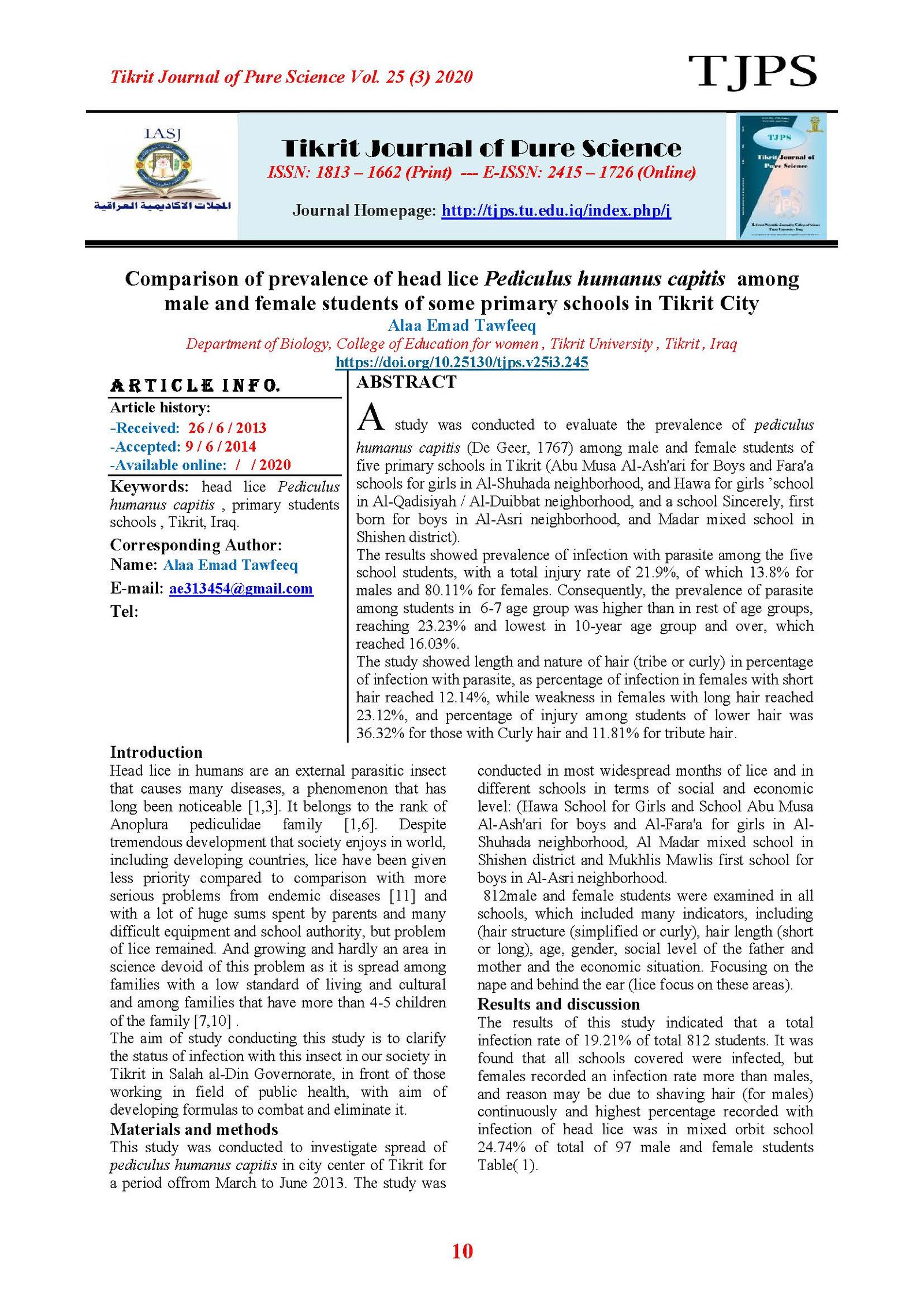Comparison of prevalence of head lice Pediculus humanus capitis among male and female students of some primary schools in Tikrit City
Main Article Content
Abstract
A study was conducted to evaluate the prevalence of pediculus humanus capitis (De Geer, 1767) among male and female students of five primary schools in Tikrit (Abu Musa Al-Ash'ari for Boys and Fara'a schools for girls in Al-Shuhada neighborhood, and Hawa for girls ’school in Al-Qadisiyah / Al-Duibbat neighborhood, and a school Sincerely, first born for boys in Al-Asri neighborhood, and Madar mixed school in Shishen district).
The results showed prevalence of infection with parasite among the five school students, with a total injury rate of 21.9%, of which 13.8% for males and 80.11% for females. Consequently, the prevalence of parasite among students in 6-7 age group was higher than in rest of age groups, reaching 23.23% and lowest in 10-year age group and over, which reached 16.03%.
The study showed length and nature of hair (tribe or curly) in percentage of infection with parasite, as percentage of infection in females with short hair reached 12.14%, while weakness in females with long hair reached 23.12%, and percentage of injury among students of lower hair was 36.32% for those with Curly hair and 11.81% for tribute hair.
Article Details

This work is licensed under a Creative Commons Attribution 4.0 International License.
Tikrit Journal of Pure Science is licensed under the Creative Commons Attribution 4.0 International License, which allows users to copy, create extracts, abstracts, and new works from the article, alter and revise the article, and make commercial use of the article (including reuse and/or resale of the article by commercial entities), provided the user gives appropriate credit (with a link to the formal publication through the relevant DOI), provides a link to the license, indicates if changes were made, and the licensor is not represented as endorsing the use made of the work. The authors hold the copyright for their published work on the Tikrit J. Pure Sci. website, while Tikrit J. Pure Sci. is responsible for appreciate citation of their work, which is released under CC-BY-4.0, enabling the unrestricted use, distribution, and reproduction of an article in any medium, provided that the original work is properly cited.
References
[1] Zangana, Ashraf Jamal Mahmoud; Tawfeq, Alaa E. and Hamdei , Raad A. (2020). Prevalence of head lice among students of some primary schools in district of Tikrit and Albu-ajil in Salah al-din province and its impact on blood picture. J. Cellular and molecular life sciences, (in postng).
[2] Noble, E.R. and Noble, G.A. (1982). Parasitology: The Biology of animal parasites,5th ed .Lea & Febiger , philadeelphia .pp:522.
[3] Al-Kubissy, W. and Abdula Karim, E.T. (2003). Head lice in pupils of two primary school in Baghdad. J .Bahrain Med. Soc.,15 :34-38.
[4] Alempour – Salemi, J; Shayehi, M.; Zeraatitti; Akbarzadeb, K.; Basseri, H.; Ebrahimi, B. and Rafinejad,; (2003). Some Aspects of Head lice infestation in Iranshahr Area (Southeast of Iran). Iranian J. of pub Health. 32(3): 60-63 .
[5] Malcolm, C.E. & Bergman, J.N. (2007).Trying to Keep a head of lice: atherapemtic challeng . skin there latter. 11:1-6.
[6] Fathy, A.G. and Semmler, M(2007). Efficacy of neem seed extract shampoo on head lice of naturally infected humans in Egypt . parasitol Res. 100:329-332.
[7] Al-Rubiay, K.K (1994). Prevalence of head lice among primary school children in two urban districts Basrah province, Iraq. Med. J. Basrah Univ. 12 (1and2):175-184.
[8] Akkas, O. and Cengiz, Z.T. (2011). Prevalence of head lice in some primary schools in Igdir province .J. Turkiye parazitol Derg. 35(4):199-203.
[9] Faust, E.C.; Beaver, P.E. and Jung, R.C.(1975). Animal agents & vectors of human disease, 4th ed . lea & febiger, phila delphia; 479 pp.
[10] Ichlpujani,R.L. and Bhatia, R.(1994). Medical parasitology., Jaypee Bros. Med. Publ. New Delhi: 384pp.
[11] Al-Kubbiassy, W.A.; Al-Rawi, J.R. and Al-Rubae, M.G., (1994) .The prevalence of head lice (Pediculus humanus capitis) among primary school pupils in Baghdad City .J. fac. Med. Baghdad, 36(4):665-670.
[12] Al-Maktari, M.T.(2008). Head louse infestation in yemen: prevalence and risk factores determination
among primary school children parasitol. 38(3): 741-748.
[13] Akkas, O., and Cengiz, Z.T. (2011). Prevalence of head lice in some primary schools in igdir province. J. turkiye parasitol derg. 3594:199-203.
[14] Shayeghi, M.; Paka, A.; Salim, A.A.; Sanei, D. (2010). Epidemiology of head lice infestation in primary school pupils, in khaji city, east azerbajan province. Iran.Iran j. Arthropod brone Dis. 4 (1):42-46.
[15] Sim.s. Lee,w. and Yu, L. (2011).. risk factores associated with head louse infestation in Korean . Korean j. parasitol., 49(1):95-98.
[16] Vahabi, A.;Shemshad, k.; Syyad, M.; Biglarian, A. and Vahabi, B. (2012).Prevalence and risk factores of Pediculus humanus capitis , in primary schools in sanadaj city, Kurdistan province, iran. Trop biomead, 29(2):207-211.
